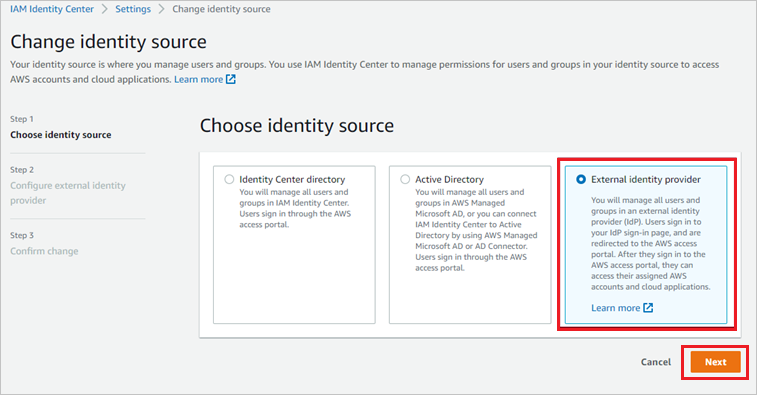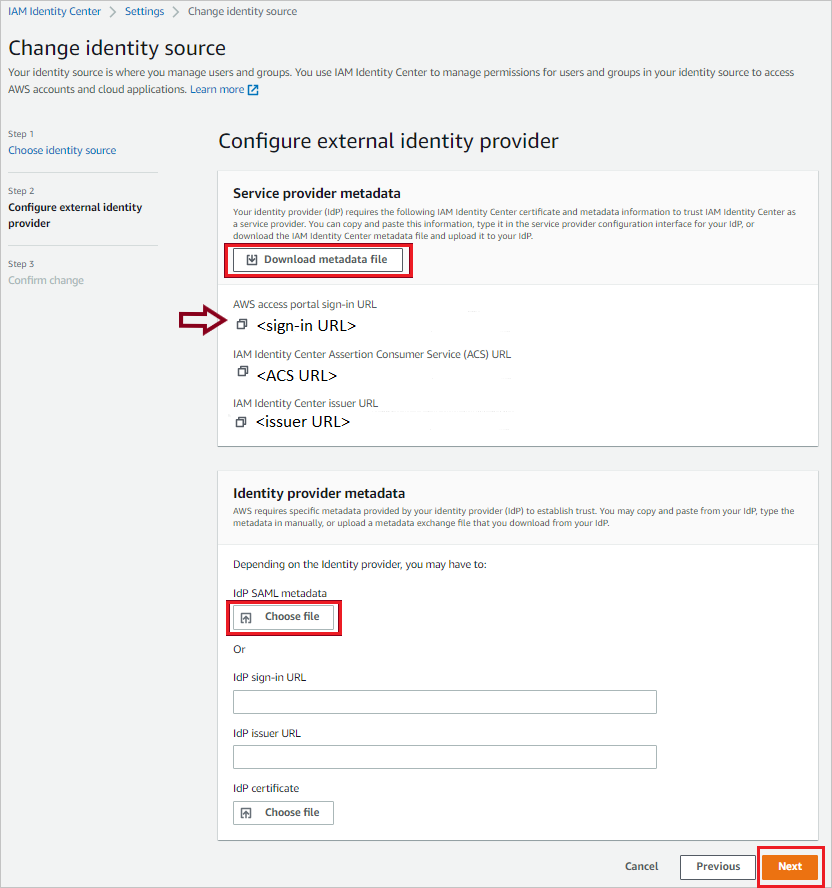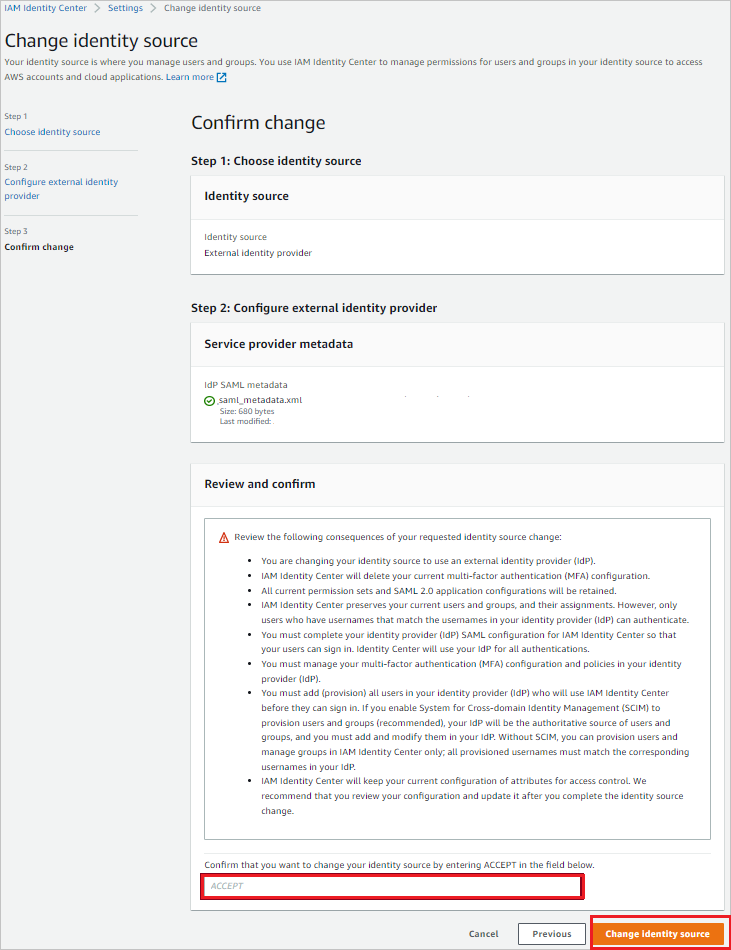Note
Access to this page requires authorization. You can try signing in or changing directories.
Access to this page requires authorization. You can try changing directories.
In this article, you learn how to integrate AWS IAM Identity Center (successor to AWS Single Sign-On) with Microsoft Entra ID. When you integrate AWS IAM Identity Center with Microsoft Entra ID, you can:
- Control in Microsoft Entra ID who has access to AWS IAM Identity Center.
- Enable your users to be automatically signed-in to AWS IAM Identity Center with their Microsoft Entra accounts.
- Manage your accounts in one central location.
Note: When using AWS Organizations, it's important to delegate another account as the Identity Center Administration account, enable the IAM Identity Center on it, and set up the Entra ID SSO with that account, not the root management account. This ensures a more secure and manageable setup.
Prerequisites
The scenario outlined in this article assumes that you already have the following prerequisites:
- A Microsoft Entra user account with an active subscription. If you don't already have one, you can Create an account for free.
- One of the following roles:
- An AWS Organizations setup with another account delegated as the Identity Center Administration account.
- AWS IAM Identity Center enabled on the delegated Identity Center Administration account.
Scenario description
In this article, you configure and test Microsoft Entra SSO in a test environment.
Note: Ensure you delegated another account as the Identity Center Administration account and enabled IAM Identity Center on it before proceeding with the following steps.
AWS IAM Identity Center supports SP and IDP initiated SSO.
AWS IAM Identity Center supports Automated user provisioning.
Add AWS IAM Identity Center from the gallery
To configure the integration of AWS IAM Identity Center into Microsoft Entra ID, you need to add AWS IAM Identity Center from the gallery to your list of managed SaaS apps.
- Sign in to the Microsoft Entra admin center as at least a Cloud Application Administrator.
- Browse to Entra ID > Enterprise apps > New application.
- In the Add from the gallery section, type AWS IAM Identity Center in the search box.
- Select AWS IAM Identity Center from results panel and then add the app. Wait a few seconds while the app is added to your tenant.
Alternatively, you can also use the Enterprise App Configuration Wizard. In this wizard, you can add an application to your tenant, add users/groups to the app, assign roles and walk through the SSO configuration as well. Learn more about Microsoft 365 wizards.
Configure and test Microsoft Entra SSO for AWS IAM Identity Center
Configure and test Microsoft Entra SSO with AWS IAM Identity Center using a test user called B.Simon. For SSO to work, you need to establish a link relationship between a Microsoft Entra user and the related user in AWS IAM Identity Center.
To configure and test Microsoft Entra SSO with AWS IAM Identity Center, perform the following steps:
- Configure Microsoft Entra SSO - to enable your users to use this feature.
- Create a Microsoft Entra test user - to test Microsoft Entra single sign-on with B.Simon.
- Assign the Microsoft Entra test user - to enable B.Simon to use Microsoft Entra single sign-on.
- Configure AWS IAM Identity Center SSO - to configure the single sign-on settings on application side.
- Create AWS IAM Identity Center test user - to have a counterpart of B.Simon in AWS IAM Identity Center that's linked to the Microsoft Entra representation of user.
- Test SSO - to verify whether the configuration works.
Configure Microsoft Entra SSO
Follow these steps to enable Microsoft Entra SSO.
Sign in to the Microsoft Entra admin center as at least a Cloud Application Administrator.
Browse to Entra ID > Enterprise apps > AWS IAM Identity Center > Single sign-on.
On the Select a single sign-on method page, select SAML.
On the Set up single sign-on with SAML page, select the pencil icon for Basic SAML Configuration to edit the settings.

If you have Service Provider metadata file, on the Basic SAML Configuration section, perform the following steps:
a. Select Upload metadata file.
b. Select folder logo to select the metadata file which is explained to download in Configure AWS IAM Identity Center SSO section and select Add.

c. Once the metadata file is successfully uploaded, the Identifier and Reply URL values get auto populated in Basic SAML Configuration section.
Note
If the Identifier and Reply URL values aren't getting auto populated, then fill in the values manually according to your requirement.
Note
When changing identity provider in AWS (that is, from AD to external provider such as Microsoft Entra ID) the AWS metadata changes and need to be reuploaded to Azure for SSO to function correctly.
If you don't have Service Provider metadata file, perform the following steps on the Basic SAML Configuration section, if you wish to configure the application in IDP initiated mode, perform the following steps:
a. In the Identifier text box, type a URL using the following pattern:
https://<REGION>.signin.aws.amazon.com/platform/saml/<ID>b. In the Reply URL text box, type a URL using the following pattern:
https://<REGION>.signin.aws.amazon.com/platform/saml/acs/<ID>Select Set additional URLs and perform the following step if you wish to configure the application in SP initiated mode:
In the Sign-on URL text box, type a URL using the following pattern:
https://portal.sso.<REGION>.amazonaws.com/saml/assertion/<ID>Note
These values aren't real. Update these values with the actual Identifier, Reply URL and Sign-on URL. Contact AWS IAM Identity Center Client support team to get these values. You can also refer to the patterns shown in the Basic SAML Configuration section.
AWS IAM Identity Center application expects the SAML assertions in a specific format, which requires you to add custom attribute mappings to your SAML token attributes configuration. The following screenshot shows the list of default attributes.

Note
If ABAC is enabled in AWS IAM Identity Center, the additional attributes may be passed as session tags directly into AWS accounts.
On the Set-up single sign-on with SAML page, in the SAML Signing Certificate section, find Federation Metadata XML and select Download to download the certificate and save it on your computer.

On the Set up AWS IAM Identity Center section, copy the appropriate URL(s) based on your requirement.

Create and assign Microsoft Entra test user
Follow the guidelines in the create and assign a user account quickstart to create a test user account called B.Simon.
Configure AWS IAM Identity Center SSO
In a different web browser window, sign in to your AWS IAM Identity Center company site as an administrator
Go to the Services -> Security, Identity, & Compliance -> AWS IAM Identity Center.
In the left navigation pane, choose Settings.
On the Settings page, find Identity source, select Actions pull-down menu, and select Change identity source.

On the Change identity source page, choose External identity provider.

Perform the below steps in the Configure external identity provider section:

a. In the Service provider metadata section, find AWS SSO SAML metadata, select Download metadata file to download the metadata file and save it on your computer and use this metadata file to upload on Azure portal.
b. Copy AWS access portal sign-in URL value, paste this value into the Sign on URL text box in the Basic SAML Configuration section.
c. In the Identity provider metadata section, select Choose file to upload the metadata file that you downloaded.
d. Choose Next: Review.
In the text box, type ACCEPT to change the identity source.

Select Change identity source.
Create AWS IAM Identity Center test user
Open the AWS IAM Identity Center console.
In the left navigation pane, choose Users.
On the Users page, choose Add user.
On the Add user page, follow these steps:
a. In the Username field, enter B.Simon.
b. In the Email address field, enter the
username@companydomain.extension. For example,B.Simon@contoso.com.c. In the Confirmed email address field, reenter the email address from the previous step.
d. In the First name field, enter
Britta.e. In the Last name field, enter
Simon.f. In the Display name field, enter
B.Simon.g. Choose Next, and then Next again.
Note
Make sure the username and email address entered in AWS IAM Identity Center matches the user’s Microsoft Entra sign-in name. This helps you avoid any authentication problems.
Choose Add user.
Next, you assign the user to your AWS account. To do so, in the left navigation pane of the AWS IAM Identity Center console, choose AWS accounts.
On the AWS Accounts page, select the AWS organization tab, check the box next to the AWS account you want to assign to the user. Then choose Assign users.
On the Assign Users page, find, and check the box next to the user B.Simon. Then choose Next: Permission sets.
Under the select permission sets section, check the box next to the permission set you want to assign to the user B.Simon. If you don’t have an existing permission set, choose Create new permission set.
Note
Permission sets define the level of access that users and groups have to an AWS account. To learn more about permission sets, see the AWS IAM Identity Center Multi Account Permissions page.
Choose Finish.
Note
AWS IAM Identity Center also supports automatic user provisioning, you can find more details here on how to configure automatic user provisioning.
Test SSO
In this section, you test your Microsoft Entra single sign-on configuration with following options.
SP initiated:
Select Test this application, this option redirects to AWS IAM Identity Center sign-in URL where you can initiate the login flow.
Go to AWS IAM Identity Center sign-in URL directly and initiate the login flow from there.
IDP initiated:
- Select Test this application, and you should be automatically signed in to the AWS IAM Identity Center for which you set up the SSO.
You can also use Microsoft My Apps to test the application in any mode. When you select the AWS IAM Identity Center tile in the My Apps, if configured in SP mode you would be redirected to the application sign on page for initiating the login flow and if configured in IDP mode, you should be automatically signed in to the AWS IAM Identity Center for which you set up the SSO. For more information about the My Apps, see Introduction to the My Apps.
Related content
Once you configure AWS IAM Identity Center you can enforce session control, which protects exfiltration and infiltration of your organization’s sensitive data in real time. Session control extends from Conditional Access. Learn how to enforce session control with Microsoft Defender for Cloud Apps.